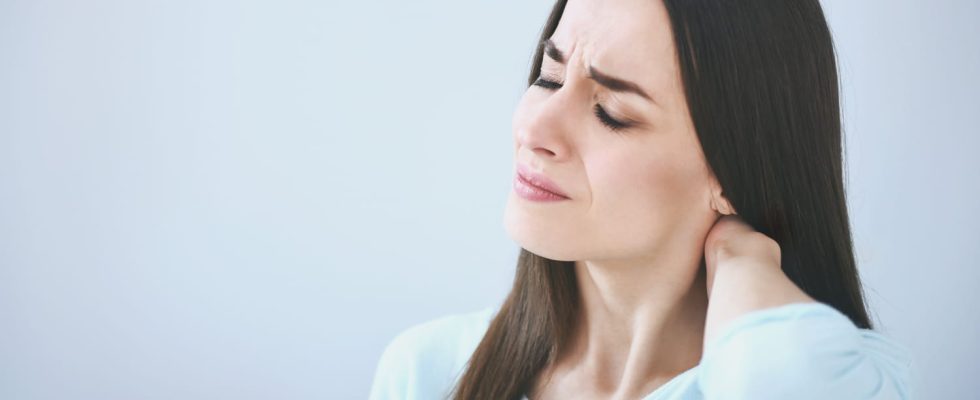Cervical osteoarthritis appears quite early because these vertebrae are very mobile. It causes neck pain, headaches and sometimes dizziness.
Cervical osteoarthritis (also called “cervicarthrosis”) manifests itself quite early because these vertebrae are very mobile and subject to numerous constraints and even trauma. However, cervixarthrosis does not always cause pain. Radiologists very often note the presence of cervical osteoarthritis and deformation of the edges of the vertebrae, the famous “parrot beaks“, fortuitously among thirty years old. After 40 years, one in two people are affectedand after 80 years old is four out of five people who suffer from it.
Definition: what is cervical spondylosis?
Osteoarthritis is here most common joint disease. It comes from a premature wear of cartilage, the gelatinous structure which lines the bony ends allowing them to slide over each other without friction. In the case of cervical osteoarthritis, the destruction affects the intervertebral discs which separate each vertebra. It particularly concerns the disc located between the 4th and 5th cervical vertebrae (C4-C5), the C5-C6 disc And the C6-C7 disc. Concretely, the cartilage thins and cracks, which causes disk compaction. This phenomenon called “discopathy” is interrupted when bony bridges form between the vertebrae (osteophytes) which immobilize the disc.
What are the symptoms of cervical spondylosis?
Cervical osteoarthritis is often asymptomatic. When it manifests, it can cause:
- of the neck pain can irradiate in the shoulder blades and shoulders and up towards the head.
- the pain is exacerbated by movement (rotation of the head for example)
- a neck stiffness
- muscle contracture,
- headaches,
- a feeling of fatigue
- and dizziness (in case of osteophytes)
What are the causes of cervical spondylosis?
“Cervical osteoarthritis is linked, in part, to the fact that the neck is a very stressed area. The mobility of our head and its weight cause significant pressure on the cervical vertebrae“, underlines Professor Aleth Perdriger, head of the rheumatology department at Rennes University Hospital. To this are also added heredity, THE after-effects of trauma which could have weakened the cervical spine or even the anomalies anatomical.
What are the consequences of cervical spondylosis?
There cervico brachial neuralgiathe equivalent ofsciatica of the arm or neck, is the main complication of cervicarthrosis. The painful area extends from the collarbone region, upper back to the arm, passing through the chest. Patients feel shooting pain, tingling, numbness and sometimes electric shocks. Of the headaches and dizziness sometimes complete the clinical picture.
To diagnose cervical spondylosis, the doctor palpate the cervical spine and analyze neck mobility and upper limbs (arms, thoracic spine). It is also based on radiological examinations (x-ray from the front, in profile and in three-quarter position) and looks for narrowing of the space between the lines characteristic of osteoarthritis or presence of bony growths, osteophytes.
It is not possible to cure cervical spondylosis. Treatment is purely symptomatic. Painful episodes, which can last several weeks, are treated with analgesics, nonsteroidal anti-inflammatories and muscle relaxants to relax the neck muscles. Regarding non-pharmacological measures, wearing a neck brace which will immobilize the cervical spine can be offered for a few weeks. Of the physiotherapy sessions can also be of great help. Surgical treatment East very rare because potentially risky given the proximity of the spinal cord. It is offered as a last resort and in very severe cases.
Generally speaking, care must be taken to limit damage to the cartilage. In general, Avoid carrying heavy loads repeatedly. Furthermore, it is recommended to use a pillow adapted to support the cervical spine. Likewise, adapt the position of your computer or television screen is important so as not to damage the articular cartilage too much.
Thanks to Professor Aleth Perdriger, head of the rheumatology department at Rennes University Hospital.
